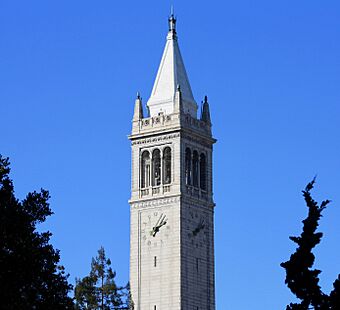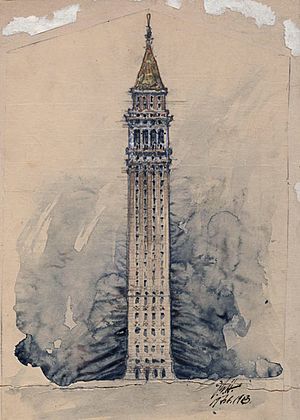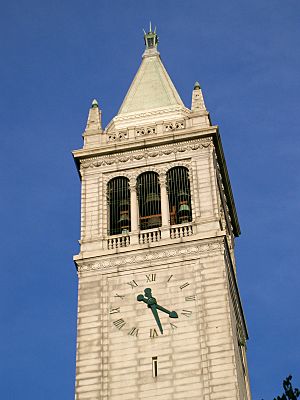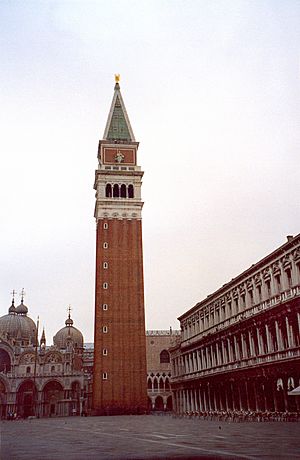Sather Tower facts for kids
|
Sather Tower
|
|

Sather Tower, photographed from ground level at midday
|
|
| Location | Berkeley, California |
|---|---|
| Built | 1914 |
| Architect | John Galen Howard |
| Architectural style | Gothic Revival |
| MPS | Berkeley, University of California MRA |
| NRHP reference No. | 82004650 |
Quick facts for kids Significant dates |
|
| Added to NRHP | March 25, 1982 |
Sather Tower is a famous bell tower located at the University of California, Berkeley. Most people know it as The Campanile (pronounced KAMP-ə-NEE-lee). It looks a lot like the Campanile di San Marco in Venice, Italy. This tower is a well-known symbol of the university.
The tower was a gift from Jane K. Sather to honor her husband, banker Peder Sather. It is the second-tallest bell-and-clock-tower in the world. Inside, there are 61 bells that make up a carillon. You can hear these bells from far away! The tower also helps teach people about campanology, which is the study of bells.
Sather Tower is also a special home for many fossils from the Department of Integrative Biology. Most of these fossils come from the La Brea Tar Pits. The tower's cool and dry inside helps keep them safe for a long time.
Contents
Exploring Sather Tower
Sather Tower stands tall at 307 feet (about 93.6 meters). This makes it the second-tallest free-standing bell-and-clock-tower in the world. It has seven main floors, plus an observation deck on the eighth floor. This deck is 200 feet (about 61 meters) above the ground.
John Galen Howard, who started the Department of Architecture at the university, designed the tower. It was finished in 1915 and opened to visitors in 1916. The tower has always been an important landmark on the campus.
The Amazing Carillon Bells
Sather Tower holds a full concert carillon. It started with 12 bells in 1917. Over time, more bells were added. In 1979, it grew to 48 bells, and by 1983, it had its current 61 bells.
The carillon plays music often. During the school year, you can hear it for ten minutes on weekdays at 7:50 a.m., noon, and 6:00 p.m. On Saturdays, it plays from 12:00–12:15 p.m. and 6:00–6:10 p.m. On Sundays, it plays from 2:00–2:45 p.m. The bells also chime every hour from 8 a.m. to 10 p.m. On the last day of classes each semester, a special song called "... Danny Deever in the Morning" is played at noon. After that, the carillon is quiet until final exams are over.
You can even learn to play the carillon! The Department of Music offers private and group lessons. Students practice on special keyboards in the tower before playing the actual bells.
Views from the Top
An elevator takes visitors 200 feet (61 meters) up to the observation deck. From there, you can see amazing views of the campus, the hills, San Francisco, and the Golden Gate. It's free for UC Berkeley students, staff, and teachers. Other visitors pay a small fee.
During "Big Game" week, the California Marching Band's trumpets play Cal spirit songs from the top of the tower. This event is called the Campanile Concert. The music fills the campus and can even be heard in Oakland!
Wildlife at the Tower
Since 2017, a pair of peregrine falcons has made their nest on top of Sather Tower. People can watch them through webcams and follow their story on the Cal Falcons social media project.
History of the Carillon Bells
The Berkeley Carillon started with twelve bells. They were made in 1915 by John Taylor & Co in Loughborough, England. These first bells were a gift from Jane K. Sather, who also gave the university the tower itself. She also gave Sather Gate and helped fund teaching positions.
The original bells were put in place in 1917. They were played for the first time on November 3, 1917. This was to celebrate California's "Big Game" against Washington. There was a delay in installing them because of World War I and customs checks.
Special Inscriptions
All the first bells have the words "Gift of Jane K. Sather 1914" on them. The biggest of these original bells has a special message from Isaac Flagg, a Greek professor: "We ring, we chime, we toll, / Lend ye the silent part / Some answer in the heart, / Some echo in the soul."
Today's bells range from small ones weighing 19 pounds to the huge 10,500-pound "Great Bear Bell." This big bell chimes every hour. It has cool carvings of bears and the Ursa Major constellation.
Growing the Carillon
People soon realized that twelve bells weren't enough to play many popular songs, like the national anthem. More bells were needed to play a wider range of notes.
In 1926, a thirteenth bell was added along with a clock to strike the hours. This clock and bell were named for William Ashburner, a university leader.
In 1978, the Class of 1928 decided to give a special gift for their 50th anniversary. They wanted to add more bells. They raised a lot of money, much more than they expected! So, they decided to expand the chime to a full carillon of 48 bells. A company from France, Fonderie Paccard, made the new bells. The new Class of 1928 Carillon, which included the original twelve bells, was installed in 1979.
A Generous Gift
In 1983, Jerry Chambers and his wife Evelyn, along with the Class of 1928, gave a very generous gift to support the carillon. These funds helped make the instrument even bigger, to a full 61 bells. They also paid for two practice keyboards, a library about bells, and a studio for the University Carillonist.
Thanks to the Chambers' gift, there is now a full-time University Carillonist. This is one of only five such positions in North America! The gift also supports a carillon festival every five years, honoring the Class of 1928.
Today, the carillon program is very active. Many students take lessons each semester. There are also many performances every week by a team of professional musicians. The generous gift from Jerry and Evelyn Chambers continues to support this wonderful program.
See also
 In Spanish: Sather Tower para niños
In Spanish: Sather Tower para niños
- List of carillons in the United States




